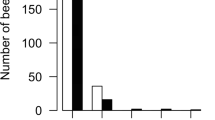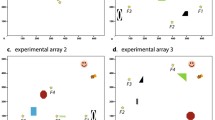Abstract
Central to the question of task allocation in social insects is how workers acquire information. Patrolling is a curious behavior in which bees meander over the face of the comb inspecting cells. Several authors have suggested it allows bees to collect global information, but this has never been formally evaluated. This study explores this hypothesis by answering three questions. First, do bees gather information in a consistent manner as they patrol? Second, do they move far enough to get a sense of task demand in distant areas of the nest? And third, is patrolling a commonly performed task? Focal animal observations were used to address the first two predictions, while a scan sampling study was used to address the third. The results were affirmative for each question. While patrolling, workers collected information by performing periodic clusters of cell inspections. Patrolling bees not only traveled far enough to frequently change work zone; they often visited every part of the nest. Finally, the majority of the bees in the middle-age caste were shown to move throughout the nest over the course of a few hours in a manner suggestive of patrolling. Global information collection is contrary to much current theory, which assumes that workers respond to local information only. This study thus highlights the nonmutually exclusive nature of various information collection regimes in social insects.







Similar content being viewed by others
References
Beshers SN, Fewell JH (2001) Models of division of labor in social insects. Annu Rev Entomol 46:413–440
Bonabeau E, Theraulaz G, Deneubourg JL, Aron S, Camazine S (1997) Self-organization in social insects. Trends Ecol Evol 12:188–193
Calderone NW, Johnson BR (2002) The within-nest behaviour of honeybee pollen foragers in colonies with a high or low need for pollen. Anim Behav 63:749–758
Cao TT, Hyland KM, Malechuk A, Lewis LA, Schneider SS (2007) The influence of the vibration signal on worker interactions with the nest and nest mates in established and newly founded colonies of the honey bee, Apis mellifera. Insectes Soc 54:144–149
Deneubourg JL, Lioni A, Detrain C (2002) Dynamics of aggregation and emergence of cooperation. Biol Bull 202:262–267
Dornhaus A, Chittka L (2004) Information flow and regulation of foraging activity in bumble bees (Bombus spp.). Apidologie 35:183–192
Dornhaus A, Chittka L (2005) Bumble bees (Bombus terrestris) store both food and information in honeypots. Behav Ecol 16:661–666
Franks NR, Pratt SC, Mallon EB, Britton NF, Sumpter DJT (2002) Information flow, opinion polling and collective intelligence in house-hunting social insects. Philos Trans R Soc Lond Series B Biol Sci 357:1567–1583
Gordon DM (1996) The organization of work in social insect colonies. Nature 380:121–124
Hölldobler B, Wilson EO (1990) The ants. Harvard University Press, Cambridge
Jeanne RL (1999) Group size, productivity, and information flow in social wasps. In: Detrain C, Deneubourg JL, Pasteels JM (eds) Information processing in social insects. Birkhauser, Basel, pp 3–30
Johnson BR (2002) Reallocation of labor in honeybee colonies during heat stress: the relative roles of task switching and the activation of reserve labor. Behav Ecol Sociobiol 51:188–196
Johnson BR (2003) Organization of work in the honeybee: a compromise between division of labour and behavioural flexibility. Proc R Soc Lond Series B Biol Sci 270:147–152
Johnson BR (2008) Within-nest temporal polyethism in the honey bee. Behav Ecol Sociobiol 62(5):777–784 DOI 10.1007/s00265-007-0503-2
Kaiser W, Steinerkaiser J (1983) Neuronal correlates of sleep, wakefulness and arousal in a diurnal insect. Nature 301:707–709
Lindauer M (1952) Ein Beitrag zur Frage der Arbeitsteilung im Bienenstaat. Z Vgl Physiol 34:299 (April, 1952)
Lindauer M (1967) Communication among social bees. Harvard University Press, Cambridge
Nakamura J, Seeley TD (2006) The functional organization of resin work in honeybee colonies. Behav Ecol Sociobiol 60:339–349
Pratt SC (1998) Decentralized control of drone comb construction in honey bee colonies. Behav Ecol Sociobiol 42:193–205
Pratt SC (2004) Collective control of the timing and type of comb construction by honey bees (Apis mellifera). Apidologie 35:193–205
Ratnieks FLW, Anderson C (1999) Task partitioning in insect societies. II. Use of queueing delay information in recruitment. Am Nat 154:536–548
Sagili RR, Pankiw T (2007) Effects of protein-constrained brood food on honey bee (Apis mellifera L.) pollen foraging and colony growth. Behav Ecol Sociobiol 61:1471–1478
Schneider SS, Lewis LA (2004) The vibration signal, modulatory communication and the organization of labor in honey bees, Apis mellifera. Apidilogie 35(2):117–131
Seeley TD (1995) The wisdom of the hive. Harvard University Press, Cambridge
Seeley TD (1998) Thoughts on information and integration in honey bee colonies. Apidologie 29:67–80
Tautz J, Casas J, Sandeman D (2001) Phase reversal of vibratory signals in honeycomb may assist dancing honeybees to attract their audience. J Exp Biol 204:3737–3746
Weidenmuller A, Tautz J (2002) In-hive behavior of pollen foragers (Apis mellifera) in honey bee colonies under conditions of high and low pollen need. Ethology 108:205–221
Winston ML (1987) The biology of the honey bee. Harvard University Press, Cambridge
Acknowledgements
I thank Rob Page and Kim Fondrk for providing resources for the experiment. Nigel Franks, Ana Sendova-Franks, Tom Richardson, Elva Robinson, Elizabeth Langridge, and three anonymous referees provided comments on the manuscript. This work was supported by a National Science Foundation Minority Postdoctoral Fellowship. The experiments reported here comply with the current laws of the USA.
Author information
Authors and Affiliations
Corresponding author
Rights and permissions
About this article
Cite this article
Johnson, B.R. Global information sampling in the honey bee. Naturwissenschaften 95, 523–530 (2008). https://doi.org/10.1007/s00114-008-0354-3
Received:
Revised:
Accepted:
Published:
Issue Date:
DOI: https://doi.org/10.1007/s00114-008-0354-3




